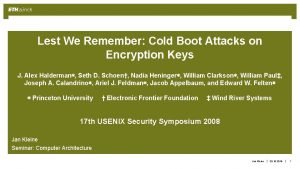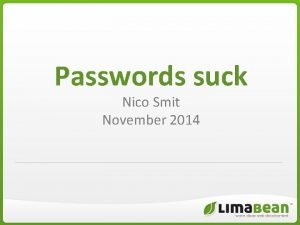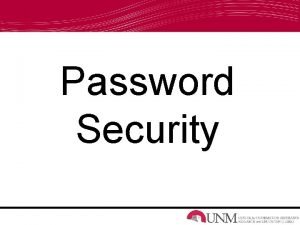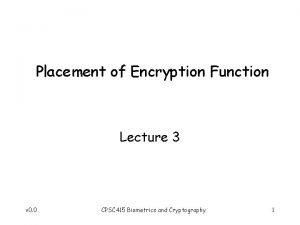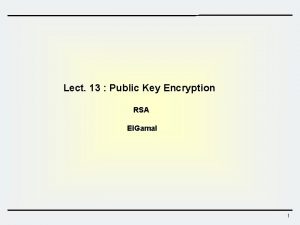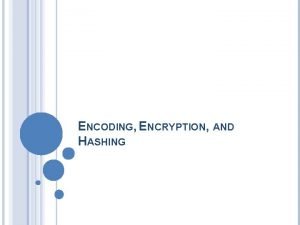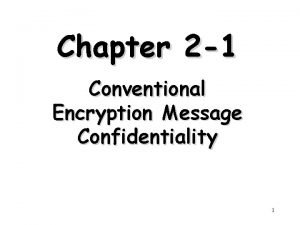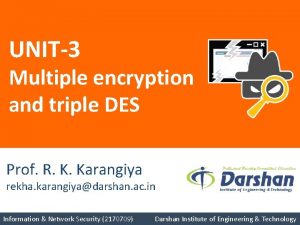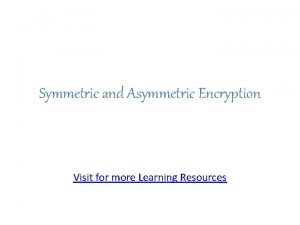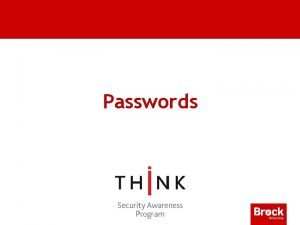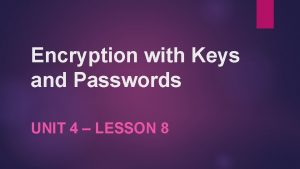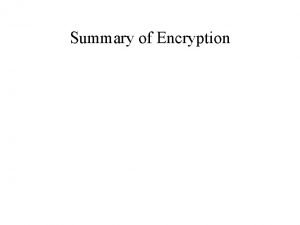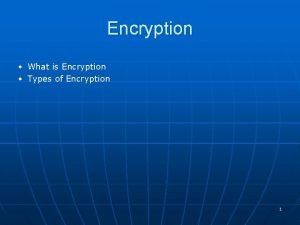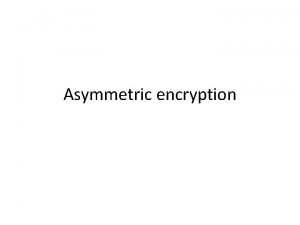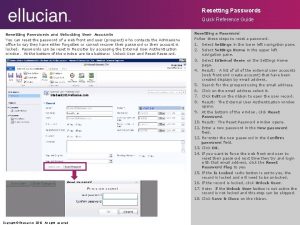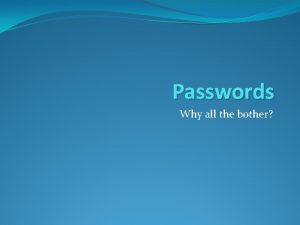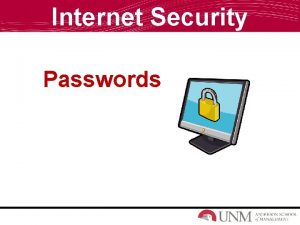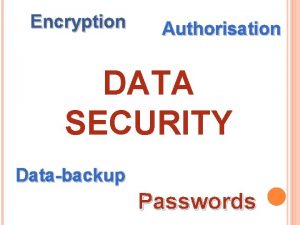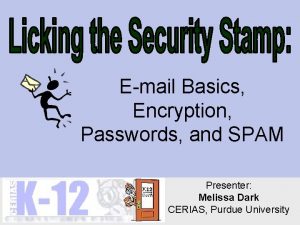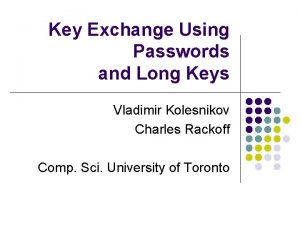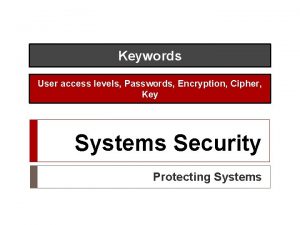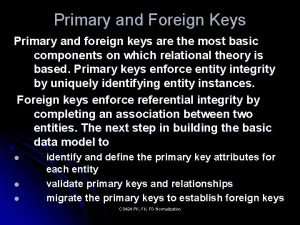Encryption with Keys and Passwords UNIT 4 LESSON



















- Slides: 19

Encryption with Keys and Passwords UNIT 4 – LESSON 6

Vocabulary Alert: Computationally Hard - a "hard' problem for a computer is one in which it cannot arrive at a solution in a reasonable amount of time. Vigenère cipher (Vee-zha-nair): a method of encrypting text by applying a series of Caesar ciphers based on the letters of a keyword. An Encryption algorithm is some method of doing encryption. The Encryption key is a specific input that dictates how to apply the method and can also be used to decrypt the message. Some people might say "What is the key to unlocking this message? "

PURPOSE: Cryptography and encryption are important and far-reaching fields within computer science. The human side of cybersecurity: choosing good passwords through an exploration of the classic Vigenère Cipher

Justification for the practice of cracking ciphers. Here are some points: People in the field of counterterrorism make a living by trying to crack the codes of other nations. Many attribute the success of the Allies in WWII to our ability to crack the Enigma code and uncover the plans of the Germans. Others may try to crack more abstract codes that are not written by humans, searching for patterns within DNA models in order to understand their nature and be able to describe the nature of humanity. It’s useful to try to crack your own codes to see how strong they really are. There are many other reasons related to mathematical exploration, pattern recognition, etc.

The Caesar Cipher is an encryption algorithm that involves shifting the alphabet The amount of alphabetic shift used to encode the message is the key When you are cracking the Caesar Cipher you are trying to figure out how much the alphabet was shifted - you are trying to discover the key.

If random substitution is an algorithm for encryption, what is the key to a random substution cipher? The key is the actual letter-to-letter mapping that was used to encode the message - it can also be used to decrypt.

There is a difference between the algorithm (how to execute the encryption and decryption) and key (the secret piece of information).

In encryption you should always assume that your 'enemy' knows the encryption algorithm and has access to the same tools that you do.

What makes encryption REALLY strong is making it hard to guess or crack the “key, ” even if the “enemy” knows the encryption technique you're using.

Today we’ll learn a little more about it and about keys and their relationship to passwords you use every day.

Distribute: Exploring the Vigenere Cipher Widget - Worksheet Students should click on the The Vigenere Cipher - Widget Use the worksheet as a guide for exploring the widget.

Part 1: Explore the Widget Students are asked to: Jump into the tool and poke around Figure out what it's doing The worksheet gives a few directed tasks: Encrypt a few different messages using different secret keys Decrypt a message Find a “bad” secret key Find a “good” secret key Try to decrypt without knowing the key

Properties of strong encryption Vigenere is strong because looking at the cipher text there are no discernable patterns assuming a good key was chosen. Because the ciphertext is resistant to analysis it leaves us simply having to guess what the key is. Even if we know the length of the key we might still have to try every possible letter combination which is a prohibitively large number of possibilities.

For a long time, the Vigenère cipher was considered to be an unbreakable cipher and was used by governments to send important messages. But in the 1800 s Vigenere was discovered to be susceptible to a modified form of frequency analysis. After that point it was considered insecure. Still the properties of Vigenere that we've found are desirable.

Computationally Hard Problems -- How good is your password? We know that a good encryption algorithm reduces the problem of cracking it to simply guessing the key. We want the key to be Computationally Hard to guess - in other words, hard for a computer to guess. Computationally Hard typically means that arriving at the solution would take a computer a prohibitively long time - as in: centuries or eons. In terms of cracking encryption that means that the number of possible keys must be so large, that even a computer trying billions of possible keys per second is unlikely to arrive at the correct key in a reasonable amount of time. Nowadays when you use a password for a website or device, your password is used as a cryptographic key. So, choosing a good password is meaningful because we want the key to be hard for a computer to guess. How good is your password? . .

Watch video: The Internet: Encryption & Public Keys - Video

Look at: How Not to Get Hacked by Code. org (not in Code. org? ) How Not To Get Hacked

Read Blown to Bits (www. bitsbook. com), Chapter 5, Secret Bits, pages 161 -165. The opening pages of Blown to Bits, Chapter 5, discuss a move the government made to try to control encryption in the aftermath of the terrorist attacks of September 11, 2001, but then dropped. Additionally, during the 1990 s, the US Government was pressuring the computer industry to be allowed to have a “back door” to decryption. Why do you think they stopped urging for this? http: //www. nytimes. com/2013/09/06/us/nsa-foils-much-internetencryption. html? pagewanted=all&_r=0 (This would weaken the public’s trust in the Internet as an e-commerce vehicle. Any back door could probably be exploited by others. The government believed they could eventually break cryptography without a back door. ) Encryption is clearly seen as essential to Internet commercial activity. That it will not be outlawed seems like a settled matter. But conversely, should it be required by government regulation? What about for other non-web media, such as mobile phone traffic and television?

TO TURN IN: 1. Exploring the Vigenere Cipher Widget 2. Worksheet: Keys and Passwords 3. Do all the activities in Code Studio 4. Think about the info on previous slide 5. Worksheet: Wireless Hotspot Problem 6. Worksheet: The Traveling Salesman Problem 7. Homework
 Lest we remember: cold boot attacks on encryption keys
Lest we remember: cold boot attacks on encryption keys Priesthood keys restored in kirtland temple
Priesthood keys restored in kirtland temple Keys to literacy keys to content writing
Keys to literacy keys to content writing Passwords suck
Passwords suck Myth world passwords
Myth world passwords What are passwords
What are passwords Googlw doc
Googlw doc Rockyou wordlist
Rockyou wordlist Houstonisdhub
Houstonisdhub Right triangle trigonometry
Right triangle trigonometry Unit 10, unit 10 review tests, unit 10 general test
Unit 10, unit 10 review tests, unit 10 general test Placement of encryption function in cryptography
Placement of encryption function in cryptography Elgamal encryption java
Elgamal encryption java Encoding encryption and hashing
Encoding encryption and hashing Conventional encryption and message confidentiality
Conventional encryption and message confidentiality Block ciphers and the data encryption standard
Block ciphers and the data encryption standard Triple des advantages and disadvantages
Triple des advantages and disadvantages Advantages of asymmetric encryption
Advantages of asymmetric encryption Bearing plates in railway track
Bearing plates in railway track Diatonic chords in major and minor keys
Diatonic chords in major and minor keys
